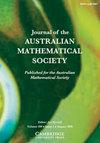ON THE NUMBER OF QUADRATIC ORTHOMORPHISMS THAT PRODUCE MAXIMALLY NONASSOCIATIVE QUASIGROUPS
IF 0.8
4区 数学
Q3 MATHEMATICS
引用次数: 2
Abstract
Abstract Let q be an odd prime power and suppose that $a,b\in \mathbb {F}_q$ are such that $ab$ and $(1{-}a)(1{-}b)$ are nonzero squares. Let $Q_{a,b} = (\mathbb {F}_q,*)$ be the quasigroup in which the operation is defined by $u*v=u+a(v{-}u)$ if $v-u$ is a square, and $u*v=u+b(v{-}u)$ if $v-u$ is a nonsquare. This quasigroup is called maximally nonassociative if it satisfies $x*(y*z) = (x*y)*z \Leftrightarrow x=y=z$ . Denote by $\sigma (q)$ the number of $(a,b)$ for which $Q_{a,b}$ is maximally nonassociative. We show that there exist constants $\alpha \approx 0.029\,08$ and $\beta \approx 0.012\,59$ such that if $q\equiv 1 \bmod 4$ , then $\lim \sigma (q)/q^2 = \alpha $ , and if $q \equiv 3 \bmod 4$ , then $\lim \sigma (q)/q^2 = \beta $ .关于产生最大非结合拟群的二次正态的个数
设q为奇质数幂,并设$a,b\in \mathbb {F}_q$满足$ab$和$(1{-}a)(1{-}b)$为非零平方。设$Q_{a,b} = (\mathbb {F}_q,*)$为准群,如果$v-u$是平方,则操作定义为$u*v=u+a(v{-}u)$;如果$v-u$是非平方,则操作定义为$u*v=u+b(v{-}u)$。如果这个拟群满足$x*(y*z) = (x*y)*z \Leftrightarrow x=y=z$,则称为最大非结合群。用$\sigma (q)$表示$Q_{a,b}$最大不关联的$(a,b)$的个数。我们证明存在常数$\alpha \approx 0.029\,08$和$\beta \approx 0.012\,59$,使得如果$q\equiv 1 \bmod 4$,则$\lim \sigma (q)/q^2 = \alpha $,如果$q \equiv 3 \bmod 4$,则$\lim \sigma (q)/q^2 = \beta $。
本文章由计算机程序翻译,如有差异,请以英文原文为准。
求助全文
约1分钟内获得全文
求助全文
来源期刊
CiteScore
1.70
自引率
0.00%
发文量
36
审稿时长
6 months
期刊介绍:
The Journal of the Australian Mathematical Society is the oldest journal of the Society, and is well established in its coverage of all areas of pure mathematics and mathematical statistics. It seeks to publish original high-quality articles of moderate length that will attract wide interest. Papers are carefully reviewed, and those with good introductions explaining the meaning and value of the results are preferred.
Published Bi-monthly
Published for the Australian Mathematical Society

 求助内容:
求助内容: 应助结果提醒方式:
应助结果提醒方式:


